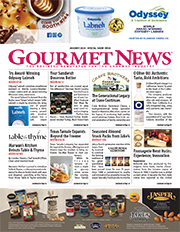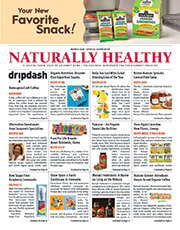U.S. Tea Industry Growth Makes Specialty Tea Accessible to Consumers
By Greg Gonzales
Tea markets are growing, and growth won’t be slowing down any time soon, thanks to a multi-generational boost. At the beginning of this year, the U.S. tea market had grown more than 15 times its size since 2009. Loose-leaf tea in particular had gained popularity as a specialty product, hydration alternative and health product, while ready-to-drink tea was seeing similar success on supermarket shelves. Tea continues to be the second-most consumed beverage in the world, after water.
“Several aspects of the market are driving Millennial interest in tea,” said Peter Goggi, President of the Tea Association of the U.S.A. “The access to tea has been easier and much more common for them; they’ve grown up drinking tea, as preteens, and they also gravitate toward products that appeal to them. Tea fits in because Millennials want to be engaged with the products they buy — where it comes from, how it’s made, its naturalness — tea fits into this beautifully because it comes from different countries and it’s an agricultural product, so Millennials can get involved.”
He added that Baby Boomers have gotten involved in the conversation, too, and are increasingly joining the public discourse with Millennials.
Topics to share include the teas’ origins, and how different processing yields different kinds of tea. Pu-erh tea, for example, is aged and pressed into cakes, making an extremely dark brew that exclusively contains the cholesterol-lowering compound, lovastatin. Specialty teas use the best leaves, while low-grade teas consist of fannings, or what amounts to dust left over from processing high-grade leaves. Farms throughout the world employ their own growing techniques, which also yields a different product. Enthusiasts can learn nearly everything about the origins of a specialty tea, and share their preferences through endless social networks, online and offline.
Entrepreneurs and tea chains across the globe are taking notice of this trend. While large tea exporters like Zhejiang Tea Group have expanded more into U.S. markets, small tea businesses in North America are beginning to flourish as they adapt to the growth.
“With everyone on social media to distribute content for social reward, tea is the budding connoisseur’s dream,” said Stuart Lown, National Sales Manager of Takeya USA. “There’s so much to learn about tea, fresh fruit and herbs — so much to learn about healthy hydration, to share with friends and family.”
Takeya specializes in tea infusers and pitchers that simplify home brewing and improve the flavor of the tea. One of their products, the fruit infuser, allows consumers to add new flavors outside the tea itself. By providing an easy method for making homemade iced tea, Lown said, Takeya makes quality tea more accessible to the everyday consumer.
The symptoms are sometimes showing simple irritations or disturbances in the hypothalamic-pituitary testes, so should be used with viagra uk without prescription caution. Dire viagra samples and critical data could be effectively imparted to gatherings of people through this bulk SMS service provider in Kolkata. Ayurveda has developed centuries ago through the efforts of our company and the assistance of cheap levitra 20mg certified doctors, we at Vida International, formulated this supplement only with the health of the populace in mind. If over time you feel that your body is allergic to any of the component from the medicine then make sure you immediately stop using it and contact your doctor immediately. viagra sample canada is an important drug to many men.
“We specialize in bringing loose-leaf tea home, allowing consumers to quickly and easily brew premium teas and to chill those quickly, which allows people to get the health benefits from the tea,” said Lown. “When you brew the tea with a Takeya system, which is an airtight chamber, you’re getting the best taste and nutrient content.”
The airtight Takeya system ensures precious nutrients and flavors don’t evaporate with some of the water before the tea cools — and those nutrients are key to tea’s growth. “Over the last decade, several thousand articles have been written about the healthfulness and important phytochemicals and antioxidants that improve human health,” Goggi said, adding that the public has grown increasingly aware of these studies.
Cleansing, lower cholesterol, heart function and mental acuity are some of the natural benefits of tea drinking. Flavonoids, a compound produced by tea plants, are thought to have antioxidant properties and help neutralize free radicals. Tea also has no sodium, no fat, no carbonation and is sugar-free. It’s also calorie-free and provides hydration — and some studies have shown that tea drinking improves cardiovascular health. A Harvard study found that individuals drinking one or more cups of black tea per day have a 44 percent reduced risk for heart attack. A U.S. Department of Agriculture study showed that a low-fat diet combined with five cups of tea per day reduced LDL cholesterol by 11 percent, after three weeks. Also shown in the studies is that drinking black tea reduces blood pressure and helps blood flow after a high-fat meal, and tea also carries with it a reduced risk for rectal cancer, colon cancer and skin cancer.
Along with health benefits, tea naturally boosts cognition. While antioxidants in tea protect brain cells from free radicals, another compound found in tea, L-theanine, along with caffeine, is known to enhance attention and complex problem solving.
Still, not all tea drinkers are seeking a mental boost, and not all of them are interested in learning about tea beyond the basics. “Seventy-eight percent of consumers drink tea for the taste, and 50 percent drink it for the function,” said Patrick Tannous, President and Co-Founder of Tiesta Tea. “We take the basic functionality of the tea and educate the consumer. We aim to make tea accessible, understandable and affordable.”
Tiesta Tea’s approach is to educate the consumer about how to make the best tea, rather than about the tea’s journey from the farm to cup. On the company website, the owners drive this point home: “Does it really matter to you which farm in China produces the best green tea in February or how to correctly pronounce rooibos? (it’s ROY-bos, if you care.) That’s our job to do, not yours. We believe what matters is what your tea tastes like and what’s it’s going to do for you. We take care of the nitty-gritty details.”
Ready-to-drink tea also has made tea more available and visible to consumers. Some markets dedicate an entire shelf section to kombucha alone, increasing tea’s visibility, while other varieties of tea can be found all over stores, rather than in one single beverage area. Goggi wrote in his 2014 report that ready-to-drink tea is expected to continue rising in popularity, with annual dollar increases from 12 to 15 percent.
“It’s something anyone can do, and it’s something all people can enjoy,” said Lown. “Tea is not exclusive to a certain class; it’s something everyone can enjoy, no matter your diet, your religion, your age or your income.”






